The first thing that football fans remember about the UEFA Euros 2016 is often that the title winners Portugal beat the hosts France in the final and showed unremarkable football throughout the whole tournament. Éder scored the only goal in the 109th minute and Cristiano Ronaldo’s team won the European Championship against Didier Deschamps’ troops.
As an Austrian, you remember this tournament in a slightly different way. Besides the fact that they participated in the Euros 2008 since they were the hosts along with Switzerland, the last time Austria were part of a European Championship was back in 1964. Due to that, the whole nation was buzzed for this tournament and several experts said that Austria would be among the secret favourites to win the title. Considering this, the whole football world and especially all Austrians expected that this could be a magical year for their national team.
However, they just got one point out of their three group stage games against Hungary, Portugal and Iceland and finished in the fourth and last place of Group F. In this tactical analysis in the form of a scout report, I’ll try to examine why Austria failed at the Euros 2016.
At first, I’ll look at every single game and give a short tactical analysis and then look at the main reasons for the failure of Austria.
Matchday one: Austria 0-2 Hungary

In the opening game of the tournament, Marcel Koller went with the expected line-up and his 4-2-3-1 formation with Robert Almer between the sticks and Florian Klein and Christian Fuchs as full-backs while Martin Hinteregger and Aleksandar Dragović were in central defence. Bayern Munich’s David Alaba and Julian Baumgartlinger played as defensive midfielders while Zlatko Junuzović was the number 10. The wings were occupied by Marko Arnautović and Martin Harnik while Marc Janko was the only striker.
Poor positioning during the build-up
Basically, it was an evenly-matched game with slight advantages for Austria when it comes to dominance. Both teams tried to build-up their attacks from the back and get control over the game. Austria had after the 90 minutes 53.16% of possession and played just four passes more than Hungary. These stats already tell that neither of the teams was really able to control the game for the majority of the time.
Hungary switched between high and an aggressive pressing and a midfield pressing when they put pressure on the Austrians at about the half-way line or several yards higher up the field. However, the high press was rarely really successful (only eight out of their 77 recoveries happened in the final third). When Hungary were out of possession and also during the high press, the number 10 László Kleinheisler moved forward along with one of the defensive midfielders, which created a 4-1-3-2. However, since Alaba and Baumgartlinger, as well as the full-backs, stayed quite deep and Almer was also always ready to receive the ball, they were always able to create a numerical superiority.
Considering this, you have to give credit to Austria for their decent work whenever Bernd Stock’s team wanted to win the ball high up the pitch. As soon as Hungary noticed that they would have almost no chance to get in possession due to the numerical disadvantage, they dropped deeper again and put pressure on the opponents in deeper areas. These were the moments in which Koller’s team had huge problems due to their positioning.
The basic idea for the build-up was clear. The full-backs push high while the wingers either slightly tuck in to stay near the full-backs or they move into the half-spaces. Meanwhile, Baumgartlinger, Alaba and Junuzović rotated a lot in the centre and had a lot of freedom. However, we saw situations like the one below in which Baumgartlinger (who is clearly the most defensive-orientated man of these three) dropped deeper between the centre-backs while the full-backs were on their way forward and Alaba was the single man in front of the newly created back-three.

In the situation above, we can also see the 4-1-3-2 formation of Stock’s team. But what you can perfectly see too is that Alaba is alone in the centre without any options nearby. The defensive midfielder Zoltán Gera was often the one who marked him closely when Alaba was the only man in the centre while Baumgartlinger was positioned deeper and Junuzović in the final third.
Alaba recognised that and tried to open up the centre by using intelligent runs to the wing as he knew that Gera would either mark him closely or at least follow him for a few yards. However, in these situations, no single player of Austria detected Alaba’s run and the consequence was that it opened up a massive pocket of space in the centre, but Austria couldn’t exploit that as no one occupied it in the first place.

Long balls and crosses: the wrong concept
Even though Austria wanted to have a build-up and the progression of the ball with short passes, they weren’t always able to do so due to their poor positioning, as we saw in the previous section of this scout report.
Even though Junuzović sometimes dropped deeper and one of the two defensive midfielders were positioned higher, they had a hard time to progress the ball through to the centre as the distance between the single players was often too big.
However, an even bigger problem was not the distance between the single players in the centre, but the huge space between the build-up players and the attacking players. As already mentioned, Austria’s full-backs usually pushed forward while at least one defensive midfielder stayed deep to help the centre-backs with the build-up. However, we often saw that the full-backs, the wingers, Junuzović and Janko were all almost on one horizontal line and between the centre-backs as well as both or one defensive midfielder (build-up players) and the other six men (attacking players) a massive space appeared.
In the image below we can see a perfect example. In this situation, Alaba was also positioned high while the right-back Klein stayed deeper, but still, we have the problem that there’s no connection between the deeper and the higher players. Due to that, Klein had to play a long ball.

Considering the already described circumstances, Austria basically tried to have a build-up with short passes in the deeper areas of the pitch, but as soon as it came to the progression into the final third, they had huge problems as there were no short passing options available. We already saw two great examples of that.
The problem was that they had so many players on one horizontal line and that led to a lack of vertical and diagonal passing options as well as triangles. And these things are exactly what you need to have a clear progression of the ball with the aid of short passes.
Due to that, they tried to get behind the last line of Hungary with long balls, which made no sense as Austria just didn’t have the right players for these tactics as none of the higher positioned players (except Arnautović) were able to beat their direct opponents in the race for the ball. Because of that, it’s also no surprise that they had a success rate of 63.1% for passes into the final third, their worst value over the three games.
Furthermore, whenever they were able to get into the final third, they mainly used crosses to create dangerous situations. They delivered 19 in total, but just six of them were successful. Of course, in Janko, Arnautović and Harnik they had three men upfront who can win aerial duels. But even though they were often in a decent position on the wing with several options to break through with a combination of short passes, they just tried to cross the ball without even considering other options.
In the example below, they had three players in the wide area and could have easily gotten themselves in a better position, but Junuzović instead went for the cross which got blocked straightaway.

Due to that, it’s also no surprise that the two most dangerous chances of Austria were individual actions by Alaba and Arnautović.
The lack of vertical compactness
As the last point of the analysis of the tactics in the first game, we have to look at the periods out of possession. Basically, the counter-pressing of Austria worked quite well, and they were often able to stop the counter-attacks of Hungary early on. However, Austria’s main problem was the lack of vertical compactness during the pressing phase and also when they sat back deeper.
Similar to Hungary, Koller’s team switched between a high press and a mid-block. During the high pressing, they mainly tried to force the opposition to play to their full-backs where they then put pressure on Hungary while Junuzović man-marked the defensive midfielder Ádám Nagy who was extremely important for Hungary’s progression of the ball.
Considering these aspects, it seems as the pattern for the pressing was well-planned. However, you often had the feeling that the offensive players and the defensive ones had different plans as the forwards (in the example below the right-winger Harnik, the striker Janko and the number 10 Junuzović) executed the press in a really aggressive way while the remaining players didn’t completely push forward. Due to that, Hungary’s left-back Tamás Kádár and the left-winger Krisztián Németh were able to solve this situation with two passes.

The second problem was that we often saw how the vertical compactness of Austria (when they sat back deeper) just wasn’t there and especially the space between the defence and the midfield was way too big.
This perfectly fitted in Hungary’s plan as they had in Ádám Szalai a tall striker upfront who they wanted to find with long balls whenever the progression with short passes wasn’t possible. Szalai then laid off the ball for one of his teammates who were in the space between the lines and since this was way too big, Hungary could exploit it several times to create dangerous situations. Exactly that also led to the 1-0 in the 63rd minute, as we can see below.

Just three minutes after the opening goal of the day, Dragović saw red and got sent off. From there on, Austria played with a 3-2-3-1 and Hungary started one counter-attack after another as Austria just wanted the equalizer and didn’t really think any more about defending at all. One counter-attack also led to the second and final goal and Austria started the tournament with a loss. On the second matchday they faced Portugal who drew with Iceland in their first clash.
Matchday two: Austria 0-0 Portugal

Compared to the first game, Koller made three changes. Sebastian Prödl replaced the suspended Dragović while Stefan Ilsanker came in for Junuzović and Alaba played behind the lone striker Harnik. Marcel Sabitzer played on the right-wing instead of Janko who played as the single striker in the first game.
The basic idea behind the adjustments
Ahead of the Euros 2016, Portugal were the clear favourites to go through in this group and most fans and experts thought that Austria would easily finish in the second place of group F. However, after the first matchday neither of these two teams got a win and Austria even lost their match against Hungary. Considering this, both nations needed to get points in this match.
Koller’s plan was simple. With the introduction of Sabitzer, he wanted to have more speed on the wing and additionally he was back then (and is still) one of the most hard-working Austrian players who tried to win every ball for his team. Sabitzer’s agility and aggression helped Klein massively on the right side (especially against Ronaldo) while his pace should have been a weapon during the counter-attacks.
With Sabitzer on the wing, Harnik moved into the centre and replaced Janko. Again, Harnik could have helped the team more out of possession as he is not as sluggish as Janko. Besides, he was the target man for Austria and we’ll come back to analyse him in more detail later in this tactical analysis.
With Ilsanker instead of Alaba in front of the back four and the Bayern Munich star as the number 10, they had one additional player in the centre who is defensively strong and can help his team massively in the moments out of possession. Additionally, this should have helped Alaba to concentrate more on the moments of offensive transition and furthermore he would always be positioned in a higher line when Austria have the ball.
Koller’s team concentrated on the defending and wanted to hurt Ronaldo and his teammates on the break.
A deep 4-4-2
Portugal had 61.47% possession and completed 441 passes (Austria completed 270). The team of Fernando Santos dominated the game and had a very fluid system as Nani, Ricardo Quaresma and Ronaldo permanently switched positions upfront while André Gomes and João Moutinho had a lot of freedom in the centre. One of them stayed deeper near William Carvalho, who manged the build-up, while the other central midfielder was positioned higher in the half-space on his side. Furthermore, the full-backs Vierinha and Raphaël Guerreiro permanently pushed forward.
So, you can already see that Portugal didn’t just have a lot of induvial quality in their side, but also wanted to dominate and win this match as they played quite offensively at all times. On the other side, Austria sat back deep in a 4-4-2 whenever Portugal had the ball and seldom pressed in at their opponents (five recoveries in the final third during the whole game). To create the 4-4-2, Alaba was positioned in the same line as the striker Harnik while the two wingers dropped back on the height of the central midfielders, as we can see below.

Even though Austria have learned from their mistakes in the first game and worked better defensively in this game (and kept the space between the lines much narrower), they had huge problems defending against the individual class of Portugal’s players and their versatility. After the 90 minutes, Portugal had an xG value of 2.78, scored one offside goal and Ronaldo missed a penalty as he hit the post.
The problem which often occurred was that the four defenders acted quite man-orientated and followed their opponents, which then created space for the other players of Portugal, as we can see in the example below when Quaresma moves into the half-space and drags Fuchs with him while Nani sprints into the newly created space. Even though Arnautović was able to intercept the pass, this was an often-used method of Santos’ team.
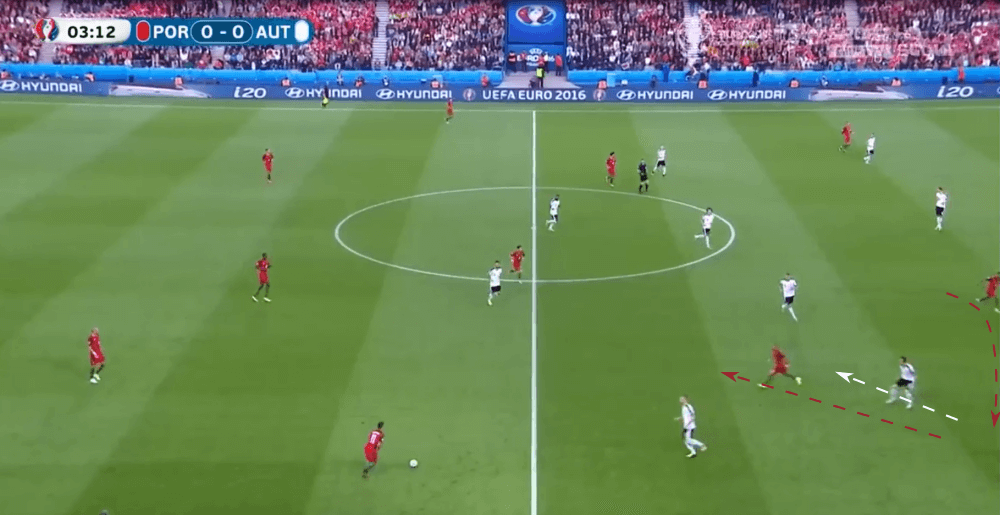
Portugal’s press and Harnik as the target man
On the other side, whenever Koller’s team had possession, Portugal mostly executed a high and aggressive pressing which was man-orientated. The big difference compared to Hungary’s press was that Ronaldo and his teammates were much more aggressive, used more players to avoid a huge numerical disadvantage and continued the press when the ball was played back to Almer.
Hungary stopped to put pressure on their opponents when the ball was played back to the goalkeeper and just shifted over to the side where Almer played the ball to. However, Portugal continued to act in a man-orientated system, cutting off all short passing options and pressing Almer too. The result was devastating for Austria since their goalkeeper is quite weak with his feet, especially when it comes to long balls. But since all passing lanes for short passes have been cut off by Portugal, Almer had no other option than to play a long ball and Austria almost always lost possession. We can see a perfect example of that in the image below.
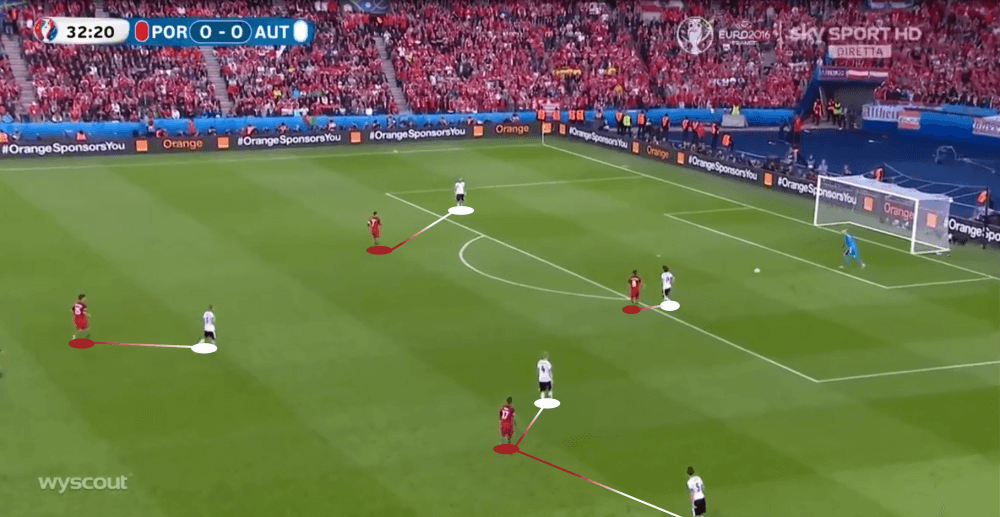
With Janko upfront, they probably would have been able to stay in possession in some of these situations when Lamer was forced to play the ball long, but you have to give credit to Koller for the introduction of Sabitzer and putting Harnik in the centre as the plan to have Harnik as the target man for long balls worked out several times before.
Harnik was neither an incredibly fast or agile player nor someone who would win every aerial duel. However, he wasn’t weak in either aspects, but rather average and it still helped him against the two centre-backs of Portugal, Pepe and Ricardo Carvalho.
However, as Austria knew that he would win some aerial duels against his opponents, but not every single one, they also often tried to find him with vertical or diagonal low-driven passes, as we can see in the example below in which they found the striker from the left side with a diagonal ball and Harnik laid it off for Ilsanker who shot from distance. This was the best chance for Austria in the whole game.
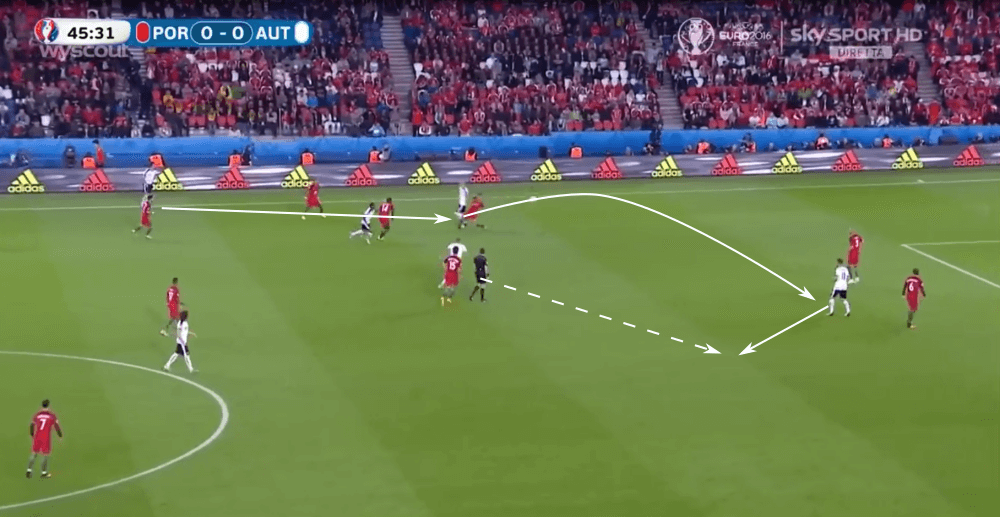
The central striker was also the one who was the target whenever they tried to start a counter-attack. Harnik dropped cleverly into free space to get on the ball and laid it off for a deeper positioned teammate and then sprinted forward again to occupy the centre upfront.
We can see an example of that below.
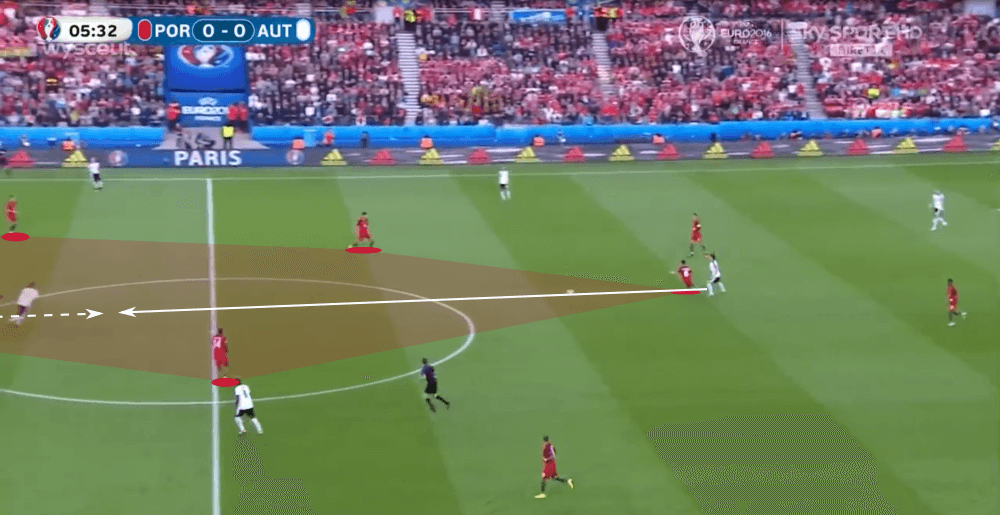
Since Austria created almost no chances (xG value of 0.17) and Portugal had weak conversion of goalscoring chances, this game ended 0-0 and Austria had to win the third game to have a chance to go through.
Matchday three: Austria 1-2 Iceland
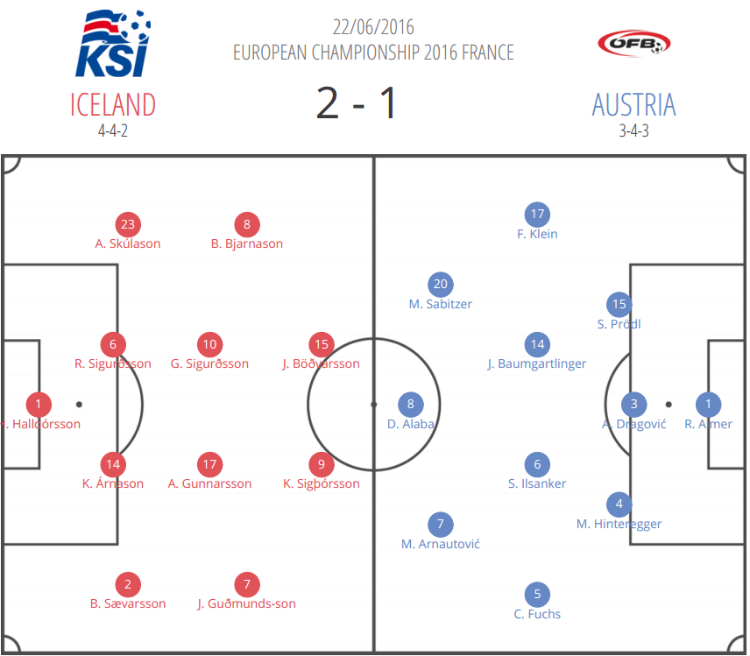
In the third game of the group stage, Koller made changes to the personnel but also switched to another system and lined up his team in a 3-4-3 formation. Dragović returned after his suspension and slotted into the back three with Prödl and Hinteregger. Alaba was the centre-forward and was supported by Sabitzer on the right and Arnautović on the left.
No ideas in the first half
The performance of Austria in the first half was quite poor while the game was as everyone expected it to be. Iceland sat back deep in their 4-4-2 formation while Austria dominated the game and had 70.03% of possession. The team of Koller build up in their 3-4-3 formation as Arnautović and Sabitzer occupied the half-spaces while the wing-backs stayed wide and were either on the height of the two central midfielders or they pushed more forward, as we can see below.
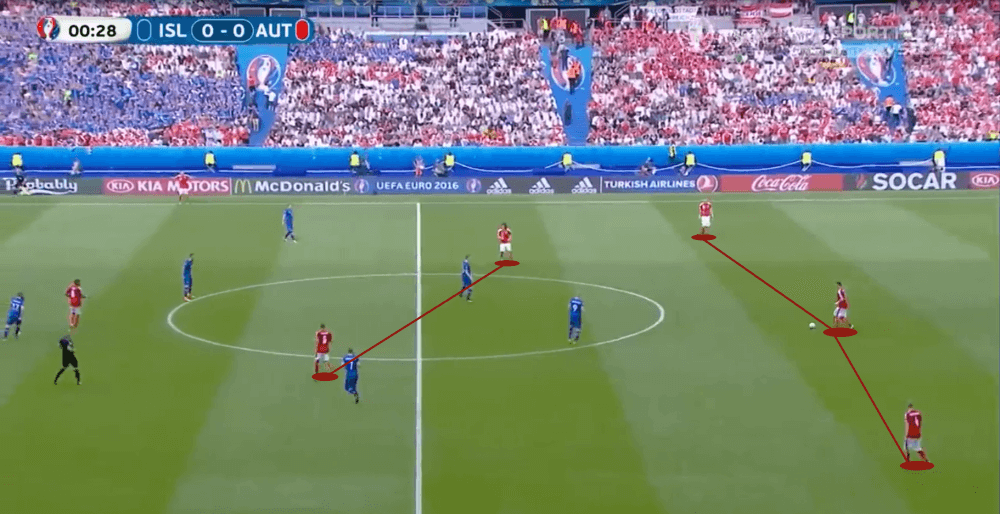
Meanwhile, Iceland sat back deep, and the two strikers started putting pressure on the Austrian players at about the half-way line. Baumgartlinger and Ilsanker had different tasks in central midfield.
While Ilsanker mainly moved inside the quartet which was made out of the two strikers and the two central midfielders of the opposition, Baumgartlinger stayed more on his right side next to Iceland’s left striker. In the example below, we can see it in action.
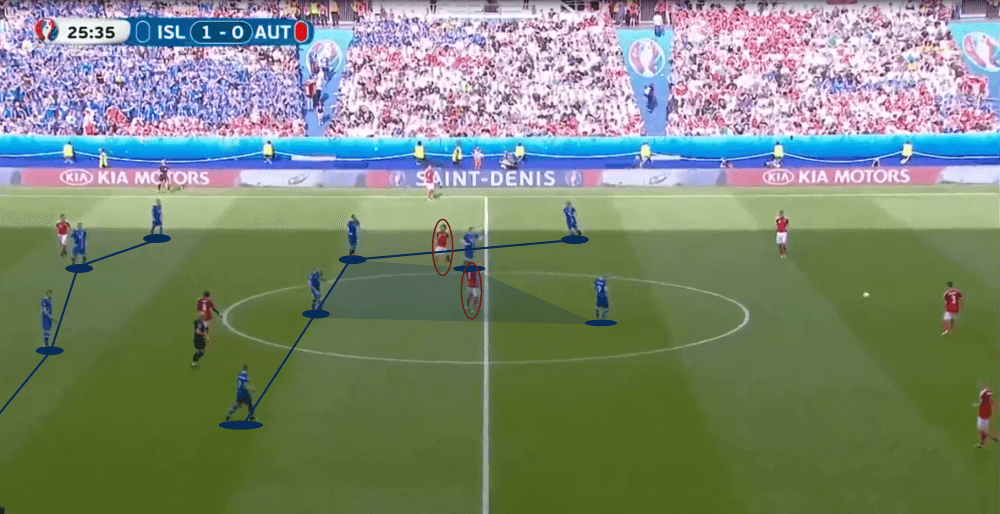
However, both men are certainly not the perfect players for a 3-4-3 formation as both are defensively strong but the progression of the ball (especially against such a horizontally and vertically compact opponent) is indeed not their greatest strength.
Besides, you had the feeling that the Austrian players didn’t exactly know how to act in this new formation and had a hard time to get forward. They were rarely able to create anything dangerous and meanwhile Iceland scored for 1-0 in the first half after a throw-in routine.
Weak pressing
Austria also stayed in their 3-4-3 out of possession and, as they did in the game against Hungary, switched between a high pressing and sitting back a bit deeper. The press was extremely man-orientated and they wanted to give Iceland absolutely no chance to have a clean and organised build-up.
Usually, the captain of the team, Aron Gunnarsson, dropped deeper at about the same height as the centre-backs who were positioned wider while the full-backs pushed forward. When Austria executed the pressing, Alaba man-marked Gunnarsson while Arnautović and Sabitzer looked after the two centre-backs.
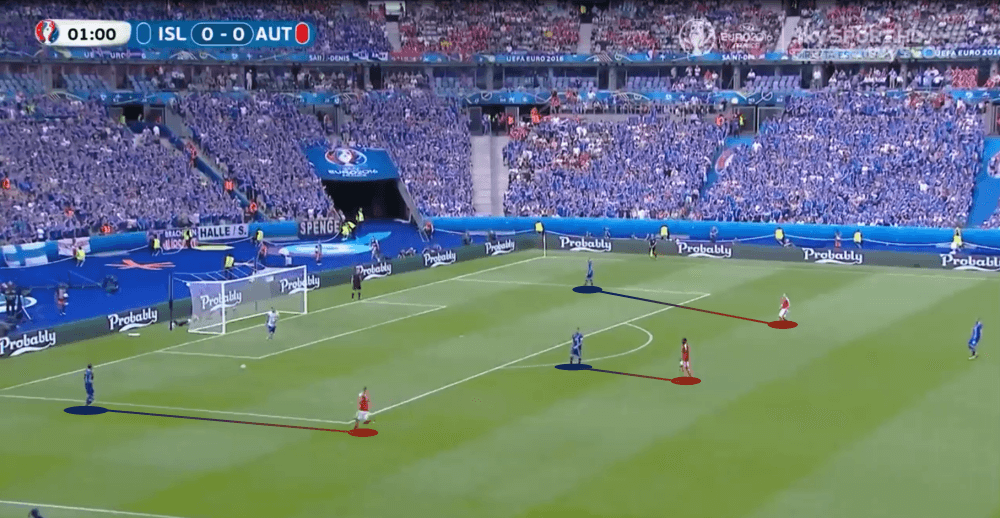
Basically, this kind of pressing could be quite effective, but Austria had again the problem which we already have seen several times in this tournament. While the forwards were positioned higher to put pressure on their opponents earlier, the remaining players stayed deeper and didn’t move forward together with their teammates to keep the vertical compactness intact.
Due to that, the press rarely worked out as Iceland easily bypassed it and exploited the space behind the three forwards of Austria, as we can see perfectly in the example below.
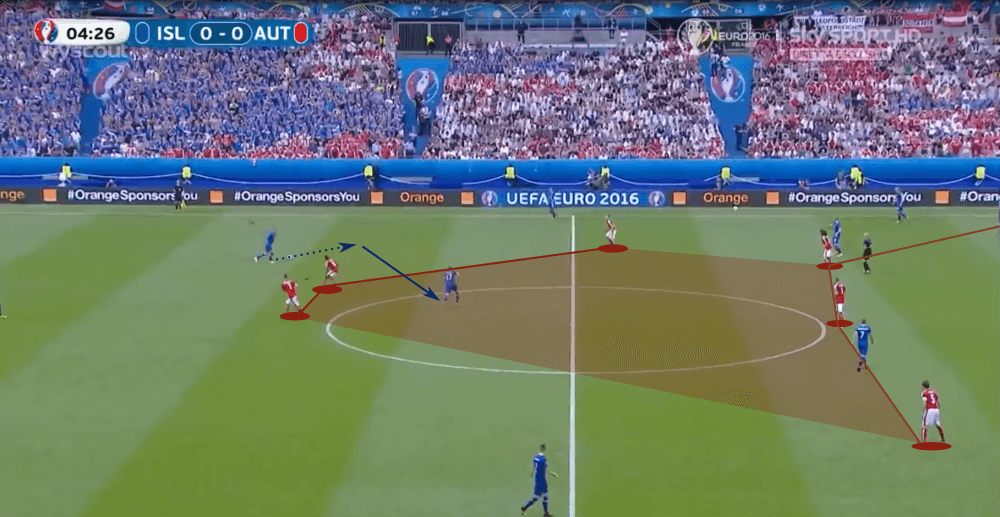
Adjustments in the second half
After halftime, Koller brought on two fresh players with Alessandro Schöpf and Janko and changed the system back to a 4-2-3-1 as he subbed off Prödl and Ilsanker. Hinteregger and Dragović were in the central defence while Fuchs and Klein played as full-backs. The double-pivot consisted out of Alaba and Baumgartlinger while Schöpf was the offensive midfielder. Arnautović and Sabitzer remained on the wings while Janko was the single striker.
Basically, this was the best half of all six by Austria at this European Championship 2016 and also the only 45 minutes in which they scored a goal. For the first time, it seemed like they had a clear plan and it was much more structured.
Since Janko was introduced, they used more crosses again and at the end of the game, they delivered them 40 times. We could often see a long diagonal switch from the right side by Dragović towards Fuchs or Arnautović on the left wing, who then delivered crosses, while Sabitzer, Schöpf and sometimes Alaba supported Janko in the box.
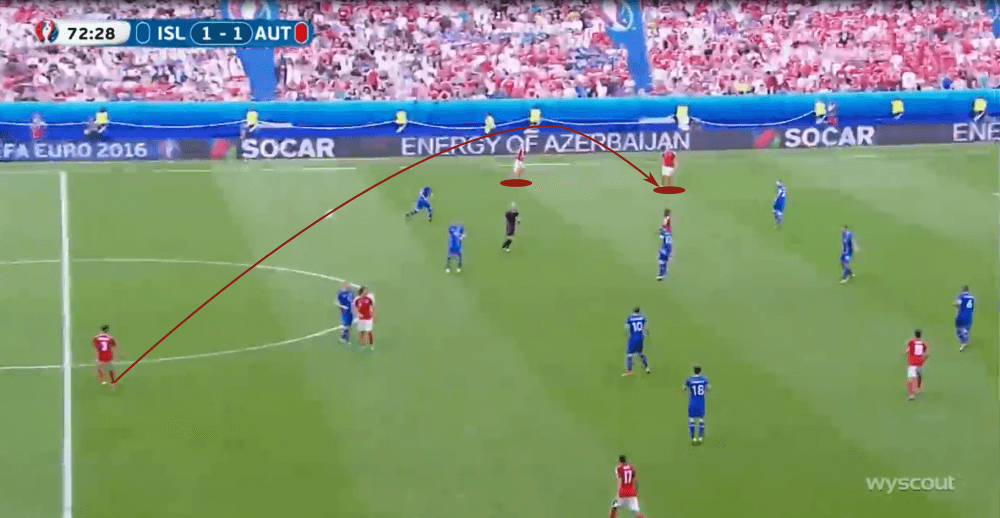
However, what I liked the most about this second half was that they were finally able to progress the ball further up the pitch with vertical or diagonal, low-driven passes. The main reasons for that was that 1) the full-backs were not always positioned extremely high but were deeper to create better passing angles and 2) Schöpf’s movements were just great to watch as he used his freedom to permanently open up passing lanes.
In the shot below, we can see the build-up ahead of Austria’s only goal of this tournament as Schöpf detected the free space, opened up the passing lane and received a good pass by Dragović. After a good little interplay with Alaba and a decent dribble, Schöpf found himself in the penalty box and scored with a simple strike.
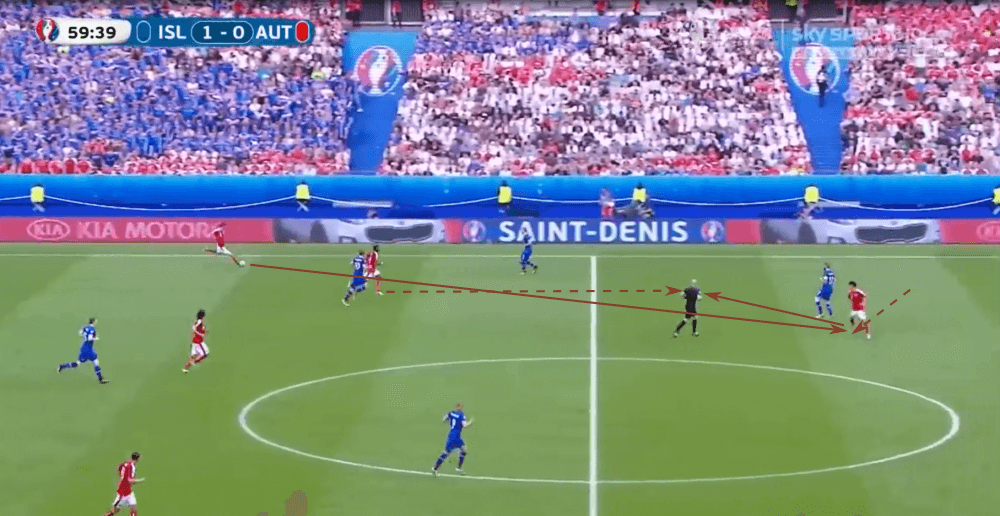
After this equaliser, Austria wanted to get the second goal to avoid elimination but in the last minute of the game, they conceded the second from a perfect counter-attack by Iceland. Still, the second half was quite decent, and the biggest problem was the conversion of their chances as they an xG value of 2.02. Even though all three games and all three opponents were completely different, I will now try to outline a few things which generally went wrong at the Euros 2016 for Austria.
What went wrong
Versatility as a weakness?
Throughout this whole tournament, you never had the feeling that Koller had his one starting XI which would be his favourite and which he fully trusts. Of course, you have to add that Junuzović got injured in the opening match of the group stage and Dragović saw a red card in that game, but still, there was no preferred line-up for the coach.
Hinteregger, both full-backs, Baumgartlinger and the two superstars Alaba and Arnautović started in every game while in the other positions, the system and the tactics changed. It’s clear you can’t play against Portugal with the same tactics as against the two other opponents but the two games against Hungary and Iceland were completely different even though the opponents were similar.
The question is now if it would have been better to just pick one starting XI and certain tactics and stick with them? Probably so, but people would’ve found faults in their systems either way.
The main problem which I want to outline are the different tactics. They used long balls to get behind the last line of Hungary with almost no fast players upfront since the space between the deeper players and the attackers was too big. And in the first half against Iceland, it seemed as they had no idea how to progress the ball further up the pitch in the 3-4-3. Koller wasn’t able to find the tactics which would fit his squad the best way or the other way around.
The best example for that is Alaba. The majority of the people say that the left-back of Bayern Munich is Austria’s best player in the last few decades. In this tournament, he started three games in three different positions. In the first game as part of the double pivot, in the second game as the number 10 and in the last game as a striker. In none of these games however, was he able to drop Bayern-level performances.
The main problem was often that it seemed as he didn’t always know where he should position himself defensively and we often saw situations like the one below when he stepped out to put pressure on his opponent way too late. This can either be because he’s not used to playing in the centre, which shouldn’t be such a big problem for a player of his level, or because the tactics of the team weren’t 100% clear.
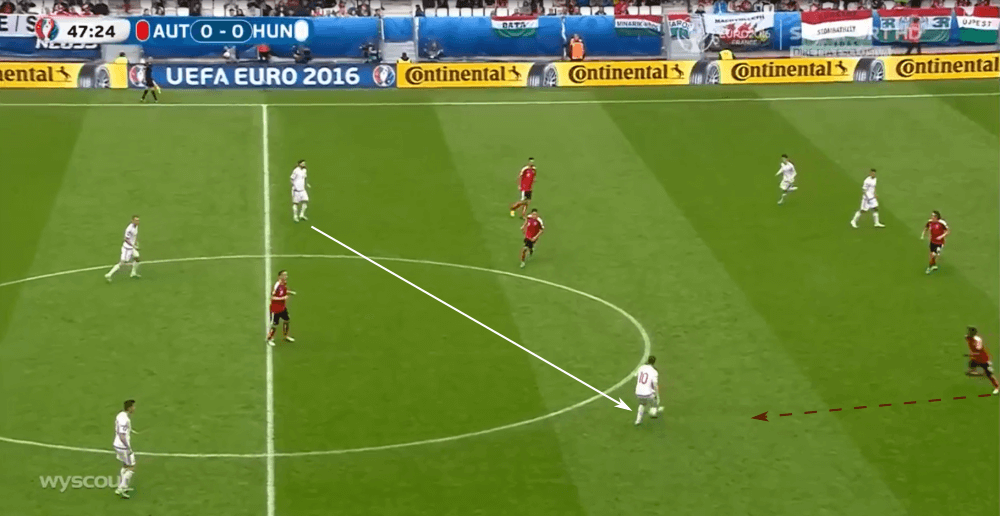
Currently, Alaba plays on the left-wing in the 4-2-3-1 in front of the left-back Andreas Ulmer and they work well together and the “left-winger” manages to drop decent performances. One major reason for that is surely also that under Franco Foda the whole team always knows which tactics they use and how they have to behave, but that’s a topic for another tactical analysis.
High pressing and space between the lines
While Koller’s team sat back deeper for most of the time in the game against Portugal, they often executed a high and aggressive pressing against Hungary and Iceland. However, in these 180 minutes, they made 188 recoveries but only 31 of them were in the final third. This number could have been much higher if the whole team worked together in these moments.
One of the basic rules of any kind of pressing is clearly that it only works out if all players work together, know the plan and execute it with the maximum of intensity. However, in the games against Hungary and Iceland, we often saw the same picture as the three or four offensive players put pressure on the opposition while the other players stayed near their opponents, but neither marked them nor cut off the passing lanes. Due to that, the press was often really ineffective.
The second problem which occurred in the games against Iceland and Hungary was the space between the defence and the midfield. No matter if they played in the 4-2-3-1 or the 3-4-3, their opponents were able to easily enter this space and hurt them several times. Also, I need to mention that this problem didn’t occur against Portugal as in this game they focused on sitting back deeper and didn’t give away any space.
Iceland and Hungary often entered the specified area by winning the second ball. While Hungary had Szalai as the target upfront, Iceland had two strikers in Jón Dadi Bödvarsson and Kolbeinn Sigthórsson. They tried to find these strikers with long balls, and they had the task to lay it off. If they weren’t able to do so, their team still often kept possession due to the distance between Austria’s defence and midfield.

Who should score the goals?
Austria scored just one goal in three games, which means that they had an average value for goals of 0.33 per 90 minutes. However, their average value for expected goals (xG) per game was one. Considering this, the problem was that Austria had a low value for the expected goals, but they were even less dangerous in front of the goal as just one in three matches is a really bad value.
Furthermore, the only goal was scored by Schöpf who isn’t even a striker as he is an offensive midfielder and winger. Janko, Harnik, Alaba and Arnautović were the players back then who you would expect to find on the score sheet.
However, Janko was already 32 years old and clearly not on such a high level anymore while Alaba and Arnautović rarely came into the positions where they could score a goal. Harnik was the central forward against Portugal but mainly had the task to lay off the ball for his teammates and did that quite well, but never found himself in goalscoring opportunities.
You often had the feeling that the team had neither a clear plan of how to progress the ball up the field and how to create goalscoring chances nor who should even score the goals.
Conclusion
Basically, the greatest question is indeed why they weren’t able to execute their plan and what exactly their idea was as sometimes you had the feeling that the players didn’t exactly know what to do. Also, a never-ending question in Austria is what’s the right role and position for Alaba in the national team. Under Koller, he mainly played as a central midfielder (sometimes more offensive and sometimes deeper) and rarely dropped such good performances as he did in the last months when the current coach Foda lined Austria up with Alaba as the left-winger.
Hopefully Foda will learn a thing or two from Austria’s performance at the Euros 2016 and his team will be able to perform better at the following Euros in 2021.




Comments